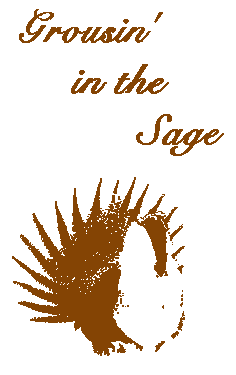
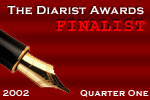 for "Bonded"
for "Bonded"
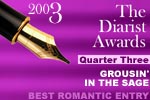 for "Hooters"
for "Hooters"
 for "Night Patrol"
for "Night Patrol"
 for "On a Dare"
for "On a Dare"
 for "Best Journal (Overall)"
Daily Sights
for "Best Journal (Overall)"
Daily Sightsour Honeymoon view a tall mountain a tall tower a comic strip

powered by SignMyGuestbook.com

|
08 November 2004
- 23:55 desert rendezvous
This
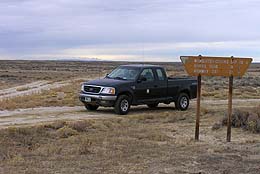 Was our meeting place.
Or, so I thought. A nondescript junction of two roads a good 15-20 miles from any human abode that has a name. Hauled ass to get there on time, too. Happily found it empty, which meant I had opportunity to let the masked heeler out for a run.
Two minutes after our scheduled rendezvous, the cell phone rings. Our habitat biologist.
Wondering where I am.
Right where I'm supposed to be. Where are you?
Turns out he misunderstood which nondescript junction we were going to meet at. But his is only three miles or so away from mine. We wait.
Then it's off to the desert unit, in tandem. Thirty years ago, in a horrendously tough winter, thousands of antelope took refuge on a low rise in the desert. Apparently the only place where wind bared off a little forage. Shortly thereafter, the outfit bought the ranch, as antelope winter range.
The antelope didn't use it again for ten years. And then again, no winter use (in any appreciable numbers) for nine more years. They were there again in the 2000-01 winter. By the carcasses they left behind, I'm not sure it was a good place to be.
But now, gas development is hitting that country. And the outfit has decided to allow grazing again. Making money off a place that is only sporadically used by antelope, money that will be spent helping wildlife and improving habitats in more critical places.
It would be nice to know what effects those changes will have. Hence, another vegetation monitoring station.
Once again we set out a hogwire cage, keeping out all but the smallest grazers from a small square of ground. A square we selected with some care, making sure it had representatives of all three forage shrubs in the area. The ubiquitous sagebrush (wyomingensis species), the fourwing saltbush (so named for the shape of its seed pods), and winterfat (A succulent-like plant, small like a forb, but with wood stems. A favored winter food of antelope, among others.)
As we work, we find quite a few chips of agate and jasper. We're not the first humans to be here. Here someone sat and flaked some primitive tools or weapons. Probably looking out over bison and antelope herds on the alkali flats and lakes below. Just knowing this country, I'd guess they were here in spring. Not much around during the other three seasons of the year. Including fresh water.
'Course, we already knew by the rusting cans up by the cactus patch that others had been here before. The detritus of uncounted sheepherder camps, left sometime over a span of almost a hundred years, when domestic sheep were the predominant grazers out here. Now, after an absence of almost twenty years, they're back.
Then, from the cage, we run another 50-bush vegetation transect. Take three steps on a bearing, and tag the nearest shrub. Measure the annular growth on ten different stems (or "leaders"), then off to the next bush.
It's a surprisingly pleasant day to work. After a week or more of cold and wind, we have patches of blue sky, and almost no wind. Yes, it's cold, but not enough to need gloves. The view's not bad, either.
Was our meeting place.
Or, so I thought. A nondescript junction of two roads a good 15-20 miles from any human abode that has a name. Hauled ass to get there on time, too. Happily found it empty, which meant I had opportunity to let the masked heeler out for a run.
Two minutes after our scheduled rendezvous, the cell phone rings. Our habitat biologist.
Wondering where I am.
Right where I'm supposed to be. Where are you?
Turns out he misunderstood which nondescript junction we were going to meet at. But his is only three miles or so away from mine. We wait.
Then it's off to the desert unit, in tandem. Thirty years ago, in a horrendously tough winter, thousands of antelope took refuge on a low rise in the desert. Apparently the only place where wind bared off a little forage. Shortly thereafter, the outfit bought the ranch, as antelope winter range.
The antelope didn't use it again for ten years. And then again, no winter use (in any appreciable numbers) for nine more years. They were there again in the 2000-01 winter. By the carcasses they left behind, I'm not sure it was a good place to be.
But now, gas development is hitting that country. And the outfit has decided to allow grazing again. Making money off a place that is only sporadically used by antelope, money that will be spent helping wildlife and improving habitats in more critical places.
It would be nice to know what effects those changes will have. Hence, another vegetation monitoring station.
Once again we set out a hogwire cage, keeping out all but the smallest grazers from a small square of ground. A square we selected with some care, making sure it had representatives of all three forage shrubs in the area. The ubiquitous sagebrush (wyomingensis species), the fourwing saltbush (so named for the shape of its seed pods), and winterfat (A succulent-like plant, small like a forb, but with wood stems. A favored winter food of antelope, among others.)
As we work, we find quite a few chips of agate and jasper. We're not the first humans to be here. Here someone sat and flaked some primitive tools or weapons. Probably looking out over bison and antelope herds on the alkali flats and lakes below. Just knowing this country, I'd guess they were here in spring. Not much around during the other three seasons of the year. Including fresh water.
'Course, we already knew by the rusting cans up by the cactus patch that others had been here before. The detritus of uncounted sheepherder camps, left sometime over a span of almost a hundred years, when domestic sheep were the predominant grazers out here. Now, after an absence of almost twenty years, they're back.
Then, from the cage, we run another 50-bush vegetation transect. Take three steps on a bearing, and tag the nearest shrub. Measure the annular growth on ten different stems (or "leaders"), then off to the next bush.
It's a surprisingly pleasant day to work. After a week or more of cold and wind, we have patches of blue sky, and almost no wind. Yes, it's cold, but not enough to need gloves. The view's not bad, either.
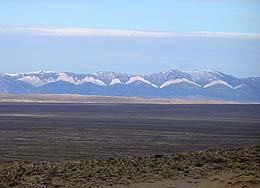 As with the other transect, the masked heeler is quickly bored, and manages to make a nuisance of herself at almost every shrub. Flinging sand into our faces as she digs a bed to settle in, only to have us move on and force her to follow, digging yet another bed.
Fifty times.
We work through what most folks would consider the lunch hour, more concerned with getting the work done before the weather decides to change. Finally, we find the one shrub we've been looking for.
As with the other transect, the masked heeler is quickly bored, and manages to make a nuisance of herself at almost every shrub. Flinging sand into our faces as she digs a bed to settle in, only to have us move on and force her to follow, digging yet another bed.
Fifty times.
We work through what most folks would consider the lunch hour, more concerned with getting the work done before the weather decides to change. Finally, we find the one shrub we've been looking for.
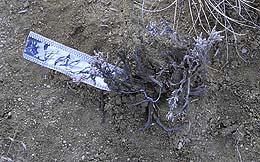 The last one.
A dinky specimen of winterfat. Well, actually, only a slightly less than average specimen of winterfat. One too small to give us the ten leaders we need to measure, forcing us to settle on only seven. But that was the nearest shrub to where my heel came down (and yes, I either close my eyes or look to the horizon when pacing, so as not to bias where that heel ends up).
Then, finally, lunch. For me, a package of cheese and crackers. We continue our pleasant conversation on religion. Knowing my partner is also a priest, I am surprised to find his congregation is a true non-denominational one. And that I have seen, in fact have photos of, his church. A small white, steepled building in the middle of what used to be a mining town, high on the Divide.
And then we're done. The vegetation will be left alone until spring. As we head our separate ways, I stop in at the old barn. The peaked north wall finally finished its collapse in the past year or so, baring the rafters used by the ravens for their nest to the north winds. Probably not enough to deter them from nesting here, but sooner or later the entire structure will collapse.
The old building appears to be a time-share. In the hayloft above the old bunkroom I find two great-horned owls, presumably scouting the place out for their winter nest.
The last one.
A dinky specimen of winterfat. Well, actually, only a slightly less than average specimen of winterfat. One too small to give us the ten leaders we need to measure, forcing us to settle on only seven. But that was the nearest shrub to where my heel came down (and yes, I either close my eyes or look to the horizon when pacing, so as not to bias where that heel ends up).
Then, finally, lunch. For me, a package of cheese and crackers. We continue our pleasant conversation on religion. Knowing my partner is also a priest, I am surprised to find his congregation is a true non-denominational one. And that I have seen, in fact have photos of, his church. A small white, steepled building in the middle of what used to be a mining town, high on the Divide.
And then we're done. The vegetation will be left alone until spring. As we head our separate ways, I stop in at the old barn. The peaked north wall finally finished its collapse in the past year or so, baring the rafters used by the ravens for their nest to the north winds. Probably not enough to deter them from nesting here, but sooner or later the entire structure will collapse.
The old building appears to be a time-share. In the hayloft above the old bunkroom I find two great-horned owls, presumably scouting the place out for their winter nest.
 Then it is homeward bound, across the alkali lakes to the paved road to the abandoned uranium mine. The towers of two drilling rigs, the latest boom to sweep this countryside, visible on the horizon.
But there is one piece of good news from the day. On the drive in this morning, we passed the new road the gas company put in two summers ago. The straight, 60+ mpg superhighway I have been using for my lek counts. They put the road in to access a well pad about seven miles north, not two miles from the largest strutting ground I've got.
I was so happy to pass the pad later and find only a solid iron pipe sticking out of the ground.
A dry well. No gas. If they'd hit gas, the company would've put up what they call a Christmas tree. A green pipe about six to eight feet tall, with numerous side valves and pipes, all painted in a colour-coordinated scheme like a Yuletide decoration, until the pipeline to drain the gas can be built and attached. Instead, I found just an iron plug in the well hole, the company's name and the legal description of the wellpad bead-welded on the side.
But they left the road intact.
Which means, they plan on coming back.
But today, as I sped merrily along towards my rendezvous at the nondescript junction, I was surprised to find this.
Then it is homeward bound, across the alkali lakes to the paved road to the abandoned uranium mine. The towers of two drilling rigs, the latest boom to sweep this countryside, visible on the horizon.
But there is one piece of good news from the day. On the drive in this morning, we passed the new road the gas company put in two summers ago. The straight, 60+ mpg superhighway I have been using for my lek counts. They put the road in to access a well pad about seven miles north, not two miles from the largest strutting ground I've got.
I was so happy to pass the pad later and find only a solid iron pipe sticking out of the ground.
A dry well. No gas. If they'd hit gas, the company would've put up what they call a Christmas tree. A green pipe about six to eight feet tall, with numerous side valves and pipes, all painted in a colour-coordinated scheme like a Yuletide decoration, until the pipeline to drain the gas can be built and attached. Instead, I found just an iron plug in the well hole, the company's name and the legal description of the wellpad bead-welded on the side.
But they left the road intact.
Which means, they plan on coming back.
But today, as I sped merrily along towards my rendezvous at the nondescript junction, I was surprised to find this.
 They're reclaiming the road! Ripping up the roadbed, leveling it, and replanting the soil.
Perhaps they're not coming back.
One can only hope.
( 1 comments on this entry )
They're reclaiming the road! Ripping up the roadbed, leveling it, and replanting the soil.
Perhaps they're not coming back.
One can only hope.
( 1 comments on this entry )
|












